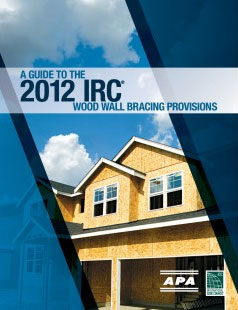
 |
| ICC, APA Team Publish IRC Lateral Bracing Guide Third edition improves understanding and application of the 2012 IRC lateral bracing requirements.  A new illustrated book, co-published by the International Code Council and APA—The Engineered Wood Association, provides an explanation of the lateral bracing provisions of the 2012 International Residential Code (IRC). The Guide to the 2012 IRC Wood Wall Bracing Provisions, the third edition in the series, details the correct application of the code-bracing requirements, explores the history and theory behind wall bracing, and provides real-world bracing examples. The book is now available in hardcopy and digital format. A new illustrated book, co-published by the International Code Council and APA—The Engineered Wood Association, provides an explanation of the lateral bracing provisions of the 2012 International Residential Code (IRC). The Guide to the 2012 IRC Wood Wall Bracing Provisions, the third edition in the series, details the correct application of the code-bracing requirements, explores the history and theory behind wall bracing, and provides real-world bracing examples. The book is now available in hardcopy and digital format. "Bracing is one of the most critical, yet most misunderstood, safety elements in one- and two-family dwellings and townhouses constructed under the IRC," says Mark A. Johnson, ICC Executive Vice President and Director of Business Development. "The Guide is an important and helpful resource for inspectors, plan checkers, builders, designers and others involved in residential construction. The ongoing collaboration between APA and ICC benefits public safety and the industry. We are pleased to build on a long-standing relationship with APA." The IRC contains numerous prescriptive lateral bracing provisions intended to help residential structures resist lateral loads that can result from wind and seismic events. The type and amount of bracing required for a given structure depends on many factors, including location and size of the structure, and the location of bracing segments within the structure. Bracing must be applied correctly and consistently to sufficiently protect the building from lateral loads, according to ICC and APA. "Most of the buildings in the U.S. are residential, and most of them are built to the IRC. Wall bracing is what makes those buildings perform well against wind and seismic loads," says co-author Ed Keith, Senior Engineer for the APA Technical Services Division. "So I would say that the bracing provisions are very important. "These provisions are complex, given the great number of aesthetic, cultural, economic and energy-related variables that factor in," says Keith. "This guide makes these provisions easy to understand." A Guide to the 2012 IRC Wood Wall Bracing Provisions addresses bracing options available to the builders and designers, the amount of bracing required with adjustments and variations, rules for the use of bracing, the new simplified wall bracing provisions, whole house bracing considerations and many other related topics. The full-color book features numerous specific examples and more than 200 figures, tables and photos. A portion of the book's content was adopted from the previous edition, A Guide to the 2009 IRC Wood Wall Bracing, and Keith adds that the 2012 version reflects several refinements to the 2009 provisions. He also notes that the book was reformatted extensively to better accommodate the user in search of specific code references. "In the book, the bracing provisions are explained in the same order as they appear in the IRC, and the top of each page is annotated with the page content, so looking up a specific provision of the code is much simpler." "The book is written to help the more causal user understand the bracing provisions," Keith adds, "but we have also provided plenty of background information and theory to clarify the principles of bracing to engineers, architects and building officials." |
| Back to top |
 |
 |
|||
Interactive DVD Equips Designers, Code Officials, Contractors Illustrated Codes for Designers: Residential explains laws, codes, standards. |
| Back to top |
Updated Masonry Handbook Includes Requirements,
|
| Back to top |
ICC Offers New Roofing Guidelines for Energy Code
|
| Back to top |
ICC-ES, APA Agree to Offer Combined Reports for Engineered Wood Products ICC Evaluation Service and APA-The Engineered Wood Association have signed an agreement to offer joint ICC-ES and APA reports for engineered wood products. The goal is to provide manufacturers with an efficient way to apply for technical evaluations with each organization and receive a joint ICC-ES evaluation report (ESR) and APA product report. |
| Back to top |
 |